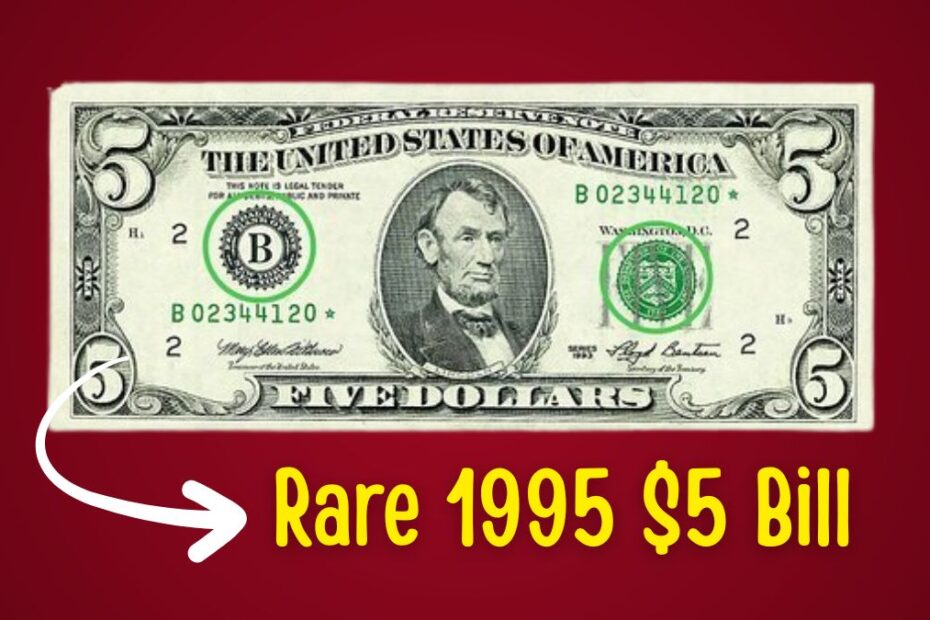Most people use paper money every day without thinking twice about it. We tuck it in our wallets, pay for groceries, and hand it over for small purchases—rarely pausing to examine what’s printed on the bill.
But every so often, a tiny detail can turn an ordinary note into something unexpectedly valuable. That’s exactly the case with the 1995 $5 bill featuring an upside-down Treasury seal, a printing mistake that has caused a stir among currency enthusiasts.
Collectors constantly search for unusual printing errors, and this particular flaw has become one of the most discussed in recent years. If you’re lucky enough to spot one, you could be holding a bill worth far more than its face value.
Why the 1995 $5 Bill Stands Out
The Series 1995 $5 bill carried a classic design, showcasing Abraham Lincoln on the front and the Lincoln Memorial on the back. Although millions were printed, only a very small number slipped past the printing process with a major flaw: the Treasury seal was mistakenly printed upside down.
Printing errors from the Bureau of Engraving and Printing (BEP) are extremely rare. When they do occur, they often become highly collectible. A genuine error—especially one this obvious—can make a bill worth hundreds or even thousands of dollars, depending on its condition.
Where the Error Appears: Spotting the Inverted Seal
To determine if your bill is valuable, you need to look in the right place. On a standard 1995 $5 bill, the green Treasury seal sits to the right of Lincoln’s portrait. The seal includes:
- A scale
- A chevron with thirteen stars
- A key
On a normal bill, all elements are printed upright.
On an error note, the entire seal is rotated 180 degrees. The key sits at the top, the text around the seal is printed upside down, and the scale hangs in the wrong direction. This isn’t a slight tilt or smudge—it’s a full and clear inversion.
If the seal simply looks worn or distorted, it is likely due to circulation, not a printing error.
Don’t Forget the Serial Numbers
Although the serial number doesn’t identify the seal error, it can help confirm authenticity. For a true BEP mistake, both serial numbers should match. If they don’t, it may indicate a different type of error.
Matching serial numbers paired with an inverted seal strengthen the evidence that the note is genuine.
Why Condition Greatly Influences Value
Collectors place enormous importance on condition. While any authentic upside-down seal error is desirable, bills in better shape bring higher prices.
Preferably, the bill should be:
- Clean and crisp
- Untorn
- Free from writing or stains
- Not severely folded or creased
- Bright, not faded
Even a circulated example holds value, but uncirculated notes fetch the highest prices.
How Much Is the 1995 Upside-Down Seal $5 Bill Worth?
The market value depends on rarity, demand, and overall condition. Generally, these prices apply:
| Condition Level | Estimated Value |
|---|---|
| Circulated | $75 – $300 |
| High-grade | $400 – $800 |
| Uncirculated or rare examples | Over $1,000 |
While prices vary depending on the collector market, one thing is certain: an upside-down seal transforms a five-dollar bill into a sought-after collectible.
How to Preserve and Sell Your Error Bill
If you believe you’ve found one of these rare notes, handle it carefully to avoid causing additional damage.
Protection Tips:
- Store the bill in a currency sleeve or protective holder.
- Keep it away from moisture, excessive handling, or direct sunlight.
Next Steps:
- Verification – Ask a reputable currency specialist to inspect your bill.
- Professional Grading – Services like PMG or PCGS Banknote can grade your note, increasing value and authenticity.
- Selling Options – Auctions, currency dealers, eBay, and collector shows are common platforms.
Always consider getting multiple opinions before making a final sale.
While most of us overlook the small details on everyday currency, rare printing mistakes like the 1995 upside-down Treasury seal remind us that hidden treasures can appear in the most ordinary places.
This unusual and highly collectible note proves that sometimes, a quick glance at your wallet could reveal far more value than you ever expected.
If you come across a 1995 $5 bill, take a moment to inspect it carefully—you may be holding a miniature fortune without even realizing it.
FAQs
How rare is the 1995 $5 bill with an upside-down seal?
These errors are extremely rare because most misprints are caught during quality control. Only a very small number reached circulation.
Do I need the bill to be uncirculated for it to have value?
Not necessarily. Even circulated error notes hold value, though uncirculated bills can sell for significantly higher amounts.
Where can I sell a rare printing error bill?
You can sell it through online auctions, currency dealers, collector shows, or through certified grading services for higher credibility.
